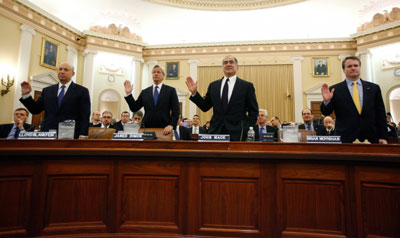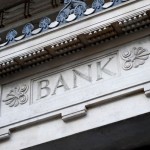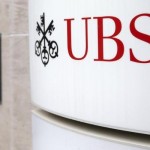Are banks looking at a shrunken future?

Amid the hundreds of billions of bad-credit write-downs and the multibillion- dollar settlements with government watchdogs since the 2008 financial collapse, it’s easy to lose sight of what good shape banks are in.
The leftover business from the crash is still claiming headlines, but the combination of Dodd-Frank and Basel III regulations, new rules on “stress-testing” balance sheets and the controversial Volcker Rule that limits proprietary trading operations have had a substantial effect. Banks are now far better capitalized, with tighter credit procedures and better risk accounting. The bigger Wall Street houses have also jettisoned many of their most volatile trading operations.
So are banks entering a new period of calm? Not a chance.
While these reforms were badly needed after the virtual wholesale deregulation of the 1990s, they almost all raise costs and limit flexibility. It is also unclear how the banks will fare once they are taken off their federal life-support systems.
The Federal Reserve has taken extraordinary measures to entice banks to lend money. It has used two main tools. The first, called quantitative easing or “QE,” has entailed the Fed buying massive quantities of securities normally held by private financial institutions. The second has been to keep the fed funds rate, or the rate at which major banks lend their short-term funds to each other, at unusually low levels.
The Fed’s use of these tools has been extremely aggressive. Take quantitative easing. The Fed is a bank and has a balance sheet. At the end of 2007, or just before the financial crash, the value of its securities portfolio totaled about $925 billion; because of QE, the Fed’s balance sheet has ballooned to $4.4 trillion. It’s safe stuff, mostly Treasuries and mortgage securities, but in normal markets, those volumes would be on the books of private institutions, not the Fed. In effect since 2008, the Fed has freed up about $3.5 trillion of new cash, nearly a fifth of annual U.S. gross domestic product, that the financial sector can recycle into the economy.
The Fed funds policy has been just as aggressive. For context, during the high-growth years of the 1990s, the fed funds rate hovered at about 5.5 percent. After the 9/11 disaster and the 2001-2002 recession, then-Federal Reserve Chairman Alan Greenspan reduced the fed funds rate to 1 percent — the lowest since the 1950s. He kept it there well after the economy had begun to recover. Then, together with his successor Ben Bernanke, Greenspan gradually moved it back to 5.25 percent by mid-2006. When the crash hit, Bernanke quickly pushed it back to 1 percent. In recent months, it’s been hovering at only a fraction of 1 percent.
How do such measures help the banks? Consider JPMorgan Chase. Last year, it had interest income of $53 billion against interest expense of only $9.7 billion, for a gross margin of 81 percent on its lending activities. In 2006, when fed funds were creeping back to 1990s levels, its gross interest margin was only 36 percent. If that same margin had applied in 2013, it would have cost JPMorgan $24 billion.
To put that number into perspective, that’s about a quarter of its annual gross revenues, and not much lower than the bank’s total compensation in 2013. So it’s fair to assume that without the Fed’s extraordinary measures, JPMorgan would be a far smaller bank.
Banks with more traditional business models, however, won’t be as exposed as a JPMorgan when the Fed’s abnormal assistance dries up. Wells Fargo, for example, is a big bank but without the investment banking and trading pretensions of a JPMorgan. A greater share of Wells Fargo’s lending is funded from customer deposits, whereas JPMorgan is more reliant on the global money markets. That’s a big advantage for Wells Fargo, because when rates start rising, retail depositors react more slowly than the money markets do.
Wells Fargo’s 2013 gross interest margin was 91 percent, even better than JPMorgan’s. In the tighter environment of 2006, its gross interest margin was substantially better — 62 percent to JPMorgan’s 36 percent.
The Fed began to ratchet down its quantitative easing program earlier this year, and its new chairman, Janet Yellen, recently announced that it will accelerate the phase-down. The stated intention, however, is to keep the fed funds rate at its current level for an unspecified period.
The extreme easy-money policy has been successful. It prevented a wholesale banking collapse in the wake of the crash and, to a somewhat lesser extent, managed to deliver measurable stimulus to the economy. Bernanke’s brave innovations deserve to be celebrated.
But as with any subsidy regime, the distortions being created may soon outweigh the good that’s been done. Since the Fed has been the major driver of the stimulus program, it has naturally used the financial sector as its primary tool, so much of the largesse has been diverted into financial-sector pockets. Disgracefully, in 2009, when the real economy was staggering, earnings and bonuses at most of the biggest banks broke records.
Cheap money also feeds asset bubbles — stock markets soar when margin rates are historically low. Keeping rates artificially low also punishes the diligent small savers with conservative retirement portfolios.
There will undoubtedly be hiccups as the stimuli are wound down. Indeed, some further stimulus may be needed. But the right course will be to put it directly into the real economy — including badly needed infrastructure repairs — where it will do more good rather than continuing to subsidize the financial-sector shareholders and executives.
By Charles R. Morris
Source: reuters





























